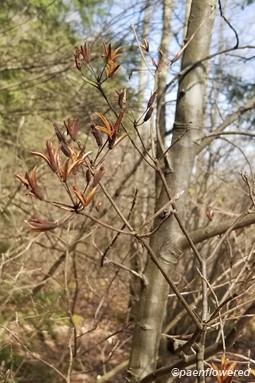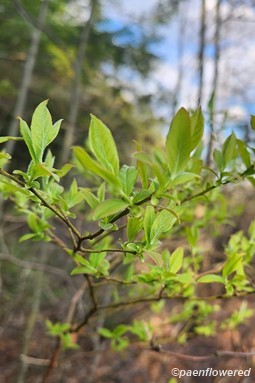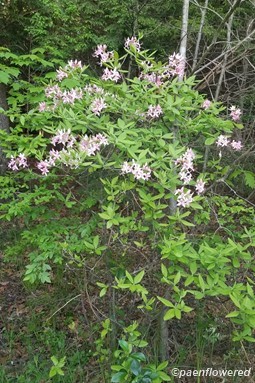Rhododendron prinophyllum
Rhododendron prinophyllum early azalea
Add to MyPlants View Locations
Early azalea, a winter-hardy shrub reaching 4 to 9 feet tall, sports beautiful, elegant rose-pink flowers that add a striking touch to forests, open areas, and riverbanks where it naturally thrives. While adaptable to various soils, it prefers acidic, moist, and well-drained conditions for optimal growth. The leaves appear before flowers, and have woolly hairs on the undersurface.
Early azalea is native to eastern Canada, northeastern United States and the Applachian mountains at higher elevataions. With branches spreading six feet or more, it offers valuable shelter for birds and other wildlife. Bees and butterflies serve as its primary pollinators, while deer and rabbits occasionally browse its foliage.
Even after its flowers have faded, the shrub remains a striking presence, as its leaves transition from bright green to rich purplish hues in the fall. Though traditionally used by the Cherokee to treat rheumatism, all parts of the plant are toxic if ingested - posing a risk to humans, horses, cats, and dogs alike.
Habitat & Range
Frequent in dry woods, thickets, and rocky slopes. Prefers dappled shade and moist, acidic, well-drained soil.
Present throughout the state.
Range: Native to eastern North America including southwestern Quebec, New England, Pennsylvania, northern Ohio and the Appalachian mountains at higher elevations.
| EMP: | FAC |
|---|---|
| NCNE: | FAC |
Phenology
Flowers May through early June. Flowers appear before or as the leaves emerge. Blooming occur for 2 to 3 weeks.
Fruits in August & September.
Characteristics
Inflorescence corymb of 4 to 12 flowers
Flowers fragrant, light pink to rarely white, funnel-shaped; coroll tube, pedicel and ovary covered with gland-tipped hairs
Leaves simple, alternate, elliptical, bright blue-green; one per node; densly covered with soft short hairs underneath
Stems round, erect; multi-stemmed
Fruit elongated capsules covered with gland-tipped hairs; release many winged seeds when mature
Bark dark gray, grooved, not exfloliating
Twigs round, smooth, dark orange-red, densly covered with soft short hairs; no scent
Buds narrow, ovoid, pointed, orange to reddish-orange; bud scales covered with dense soft short hairs
Height/Spread 4-8 feet tall spreading 6-12 feet
Age 30 to 50 yrs
Fall Color bronze to purplish
Identification Tips
There are glandular hairs on corolla tube, ovaries and pedicels.
Plant Codes
S-rank: S5 (Secure)
G-rank: G5 (Secure)
Ecology
Butterflies, bumblebees, and hummingbirds serve as the primary pollinators of this plant. However, when pollinators are scarce, studies have shown that it can rely on self-fertilization for reproduction. With its wide-spreading branches, it provides valuable shelter and cover for both birds and mammals. While it tolerates browsing by rabbits, it is frequently damaged by deer.
Rhododendron prinophyllum early azalea
Synonyms: Azalea prinophylla, Rhododendron roseumAdd to MyPlants View Locations











Comments
Have you spotted this plant in your area? We'd love to hear about your experience! Share your comments or questions about the plant below. Comments are moderated before posting.